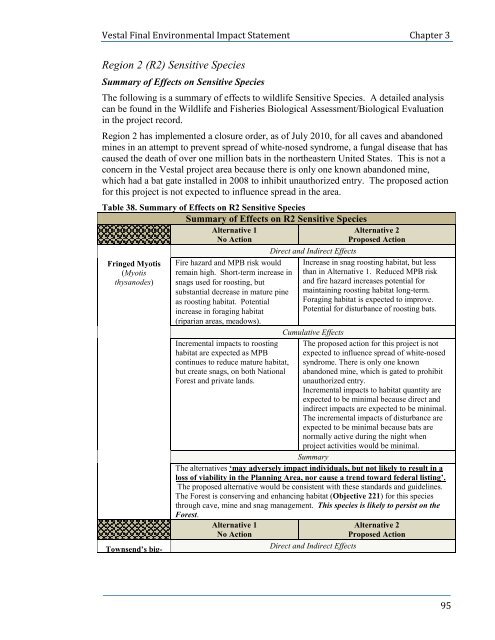Final Environmental Impact Statement
Final Environmental Impact Statement
Final Environmental Impact Statement
Create successful ePaper yourself
Turn your PDF publications into a flip-book with our unique Google optimized e-Paper software.
Vestal <strong>Final</strong> <strong>Environmental</strong> <strong>Impact</strong> <strong>Statement</strong> Chapter 3<br />
Region 2 (R2) Sensitive Species<br />
Summary of Effects on Sensitive Species<br />
The following is a summary of effects to wildlife Sensitive Species. A detailed analysis<br />
can be found in the Wildlife and Fisheries Biological Assessment/Biological Evaluation<br />
in the project record.<br />
Region 2 has implemented a closure order, as of July 2010, for all caves and abandoned<br />
mines in an attempt to prevent spread of white-nosed syndrome, a fungal disease that has<br />
caused the death of over one million bats in the northeastern United States. This is not a<br />
concern in the Vestal project area because there is only one known abandoned mine,<br />
which had a bat gate installed in 2008 to inhibit unauthorized entry. The proposed action<br />
for this project is not expected to influence spread in the area.<br />
Table 38. Summary of Effects on R2 Sensitive Species<br />
Summary of Effects on R2 Sensitive Species<br />
Alternative 1<br />
Alternative 2<br />
No Action<br />
Proposed Action<br />
Direct and Indirect Effects<br />
Fringed Myotis Fire hazard and MPB risk would Increase in snag roosting habitat, but less<br />
(Myotis remain high. Short-term increase in than in Alternative 1. Reduced MPB risk<br />
thysanodes) snags used for roosting, but<br />
substantial decrease in mature pine<br />
as roosting habitat. Potential<br />
increase in foraging habitat<br />
(riparian areas, meadows).<br />
and fire hazard increases potential for<br />
maintaining roosting habitat long-term.<br />
Foraging habitat is expected to improve.<br />
Potential for disturbance of roosting bats.<br />
Incremental impacts to roosting<br />
Cumulative Effects<br />
The proposed action for this project is not<br />
habitat are expected as MPB expected to influence spread of white-nosed<br />
continues to reduce mature habitat, syndrome. There is only one known<br />
but create snags, on both National abandoned mine, which is gated to prohibit<br />
Forest and private lands.<br />
unauthorized entry.<br />
Incremental impacts to habitat quantity are<br />
expected to be minimal because direct and<br />
indirect impacts are expected to be minimal.<br />
The incremental impacts of disturbance are<br />
expected to be minimal because bats are<br />
normally active during the night when<br />
project activities would be minimal.<br />
Summary<br />
The alternatives ‘may adversely impact individuals, but not likely to result in a<br />
loss of viability in the Planning Area, nor cause a trend toward federal listing’.<br />
The proposed alternative would be consistent with these standards and guidelines.<br />
The Forest is conserving and enhancing habitat (Objective 221) for this species<br />
through cave, mine and snag management. This species is likely to persist on the<br />
Forest.<br />
Alternative 1<br />
Alternative 2<br />
No Action<br />
Proposed Action<br />
Townsend’s big-<br />
Direct and Indirect Effects<br />
95

















